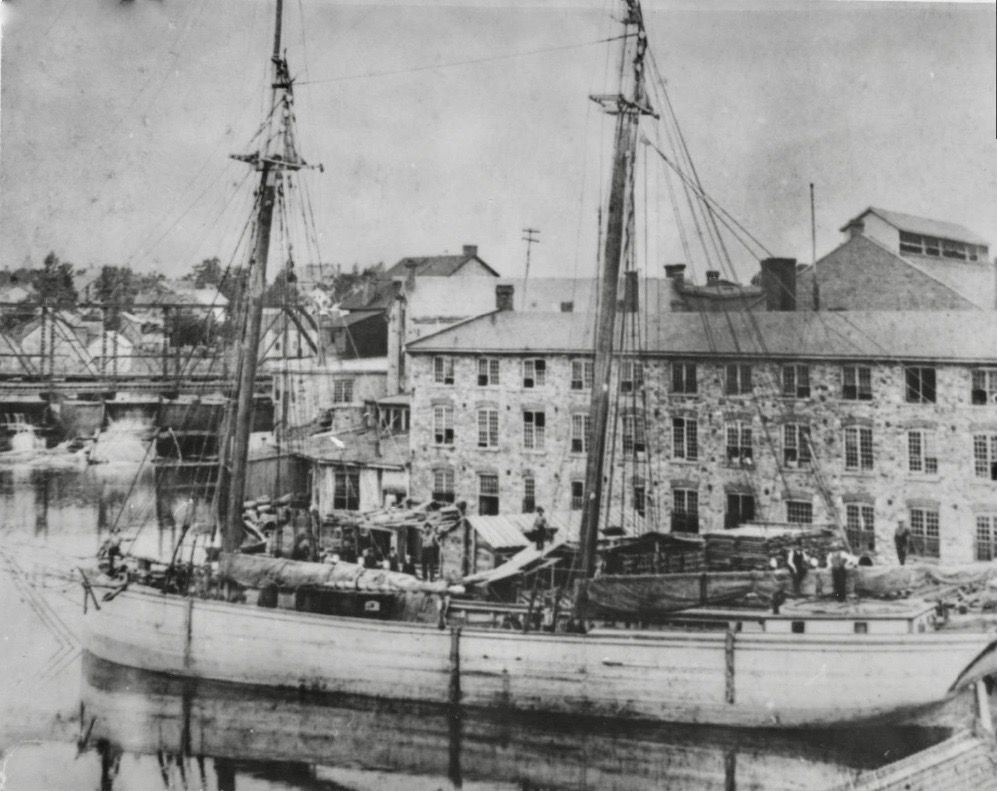Editor's note: Schooner Days Project
Earlier this summer, author Richard Palmer helped complete a special project for the Maritime History of the Great Lakes Website.
Richard reports that with comparatively few gaps, they're drawing closer to completing the massive "Schooner Days Project." For those interested in Great Lakes maritime history, we have C.H.J. Snider (1879-1971) to thank. Beginning in 1931 and ending more than two decades later, Snider chronicled this era in 1,303 "Schooner Days" columns for Toronto’s The Evening Telegram. Not only do we recognize Snider for his writing, but also as a fine Canadian artist. His biographer says Snider himself worked aboard schooners in his youth, and studied first-hand the development of the Great Lakes region.
Richard joined others in transcribing these articles for researchers. Richard writes, "So far, Walter Lewis has finalized and posted 537 of the articles on the maritimehistoryofthegreatlakes.ca website, all word searchable. There are a total of 1,303, with the possibility there were several more that were in typed from, but never published in the Toronto Telegram.
Palmer is now closing in on Schooner Days #1,260. It has been an arduous journey of more than a year and a half of pandemic and a real challenge to draw from numerous sources. Richard says they owe a debt of gratitude to Ron Beaupre, who generously made his collection available. Also, the great assistance was given by Mark Sprang, Archivist, Historical Collections of the Great Lakes at Bowling Green State University.
The Schooner Days Project group says, "Hopefully we’ve located a source that has most of the missing ones and we can ensure that the days of schooner travel on the Great Lakes will be preserved forever."
Below is one article that Richard is sharing with TI Life. He chose it because the photograph of the schooner, Picton, captures the waterfront in Gananoque during Schooner days - do you recognize it?
Editor: Susan W. Smith, info@thousandislandslife.com

Many small schooners were still transporting coal from ports such as Rochester (Charlotte), Sodus Point, Fair Haven, and Oswego to Canadian ports long after they should have been consigned to the “bone yard.” One of these vessels was the schooner Picton. She and her ilk were more than 30 years old and on their “last legs” by the time the 20th century rolled around.
The schooner “Picton” finally ran out of luck. Her story was told in the Syracuse Herald on July 3, 1900.
Foundering of the Schooner Picton
The schooner Picton of Bellville, Ont., a Lake Ontario hooker, bound for Kingston, Ont., went down off Charlotte Sunday afternoon [July 1] during a gale of wind blowing from the Northwest and all on board, including the captain, his son and four men were lost. The Picton was a fore and aft rigged craft, owned at Belleville, Ont., by Captain Sidley, and was engaged in the coal trade.
She was built a quarter of a century ago and was a good vessel in her day. But time and weather had laid its hand heavily on her, and although she weathered the gales on the lakes for many years, like the pitcher that went to the well, it ventured outside once too often and found its resting place at the bottom of the lake, where it will keep silent company with hundreds of other craft which have met a similar fate, and its brave crew of six souls will join the thousands whose graves are in the bottom of old Ontario.
The Picton left Charlotte in company with the schooner Acacia, bound for Kingston, and after the two vessels were outside they were struck by a squall which came out of the Northwest. Instead of subsiding, as sudden storms of this kind usually do, the wind increased in fury, and the lake, which was as placid as a mill pond when the two boats sailed outside, was lashed into a fury and the waves ran mountains high.
Capt. Byron Bougard of the Acacia succeeded in getting in the greater part of his sail and scudded before the wind and saved his boat. Captain Sidley either did not notice the fast approaching storm quick enough, or his rigging must have become jammed, for his sails were all standing when the storm struck. The sails were whipped into ribbons in a minute’s time, and the main mast, it is said, went by the board. The heavy boat plunged and heaved in the heavy seas, and although everything possible was done to clear away the wreckage the seas ran so high and were constantly breaking over the doomed craft that the members of the crew, who were fighting for their lives as only doomed men can, were swept from the deck of the schooner and into the lake, where they were drowned. It was impossible to lower away a boat for the small yawl secured in the davits at the stern of the schooner would scarcely have touched the water before it would have been crushed like an egg shell, the waves were so enormous.

Captain Bougard watched the schooner, unable to render the slightest assistance, until it disappeared from view and he came to the conclusion that it had foundered and was the first to report the fact when he reached his destination, Kingston, Ont.
All doubts regarding the fate of the Picton were removed when Captain Savage of the schooner Annie Minnes reached Belleville. He, too, was caught in the storm, and although his vessel was badly damaged, he succeeded in outliving the gale and sailed into port. He was within two miles of the Picton when she was battling with the elements and saw her take her last fatal plunge, but was unable, on account of the high seas, to render the crew any assistance. As soon as he reached Belleville he reported the loss of the schooner.
The foundering of the Picton is but another vacancy in the noble line of vessels which have ploughed Lake Ontario for the last half a century and have one by one either found a grave in the deep water or been piled up on the rocks along the shores. This class of craft were considered able to outride the severest storm when they were built, and they could. But of late years the competition with the steamers and railroads have made the freight rates so low that the owners could barely eakout a living, let along give to their boats the necessary repairs to make them safe and seaworthy.
Every spring the owners, when they fitted these boats out, have said it would be the last time, but after a hard winter and when the family larder was low they would try it just one more season. And is always easy to gather together a crew to man these floating coffins, for they are little better than that. Necessity knows no law, and the hundreds of men who have followed the lakes for a living when sailing was good and the boats new and safe are ever on the lookout for a situation.
Men who hold first class papers as pilots on the lakes, from Duluth to Ogdensburg, and are competent to take command of any craft navigating these waters, are found among the members of the fo’castle of just such boats as the Picton.
The crew of the Picton all lived at Belleville, Ont. It was at first thought Captain Sidley was accompanied by his wife and family, but it was later learned that his 11-year-old son, Sylvester, was the only one of his family on board. The mate, Frank Smith, and the cook, Bernard Myers, were men with families, but the rest, Walter Dunn and William Bligh, were unmarried.
Oswego Daily Times
Monday, August 20, 1890
Found in a Flask
Last Message of Captain John Sidley of Schooner Picton
CLAYTON, August 20. 1890 - Theobald F. Clark, the young son of Wilton Clark of Philadelphia, Pa., who owns a summer home at the foot of Long Island, discovered Saturday morning a flask containing a message from Captain John Sidley of the Canadian schooner Picton, which was lost in Lake Ontario near Oswego on June 29th last, with all hands.
The flask was an ordinary pint whiskey flask and the message enclosed was written with a lead pencil on pure white wrapping paper, evidently torn hastily. The paper had turned yellow around the edges and showed evidence of having been in the water for some time.
Contents of Bottle
The message, written in a cramped hand, was as follows: “John Sidley, Captain of the schooner Picton, in great peril; expect to sink any minute. Good-bye to all friends. Finder please report this to my wife.”
Mr. Clark is positive that the message is authentic and will send it to the Captain’s wife at Bellville, Ont.
His son found it on the south side of Howe Island, near the head. The flask had been washed ashore and the boy picked it up. He started to throw it into the water, when he noticed the paper inside. He took it to his father who preserved it.
The schooner Picton of Belleville, lost on June 29, was loaded with coal and was lost between this port and Big Sodus. She was last seen in distress by the Captain of a schooner bound for Kingston. He was unable to render any assistance.
(Note: The two-masted schooner Picton was built by Thomas Walters at Picton in 1867. Dimensions: 98’4” length; 22’9” width and 9” 7” depth, 160 tons. (Canadian registration #71206).
Originally written by C.H.J. Snider (1879-1971) and compiled for research by Richard Palmer.
Richard F. Palmer is a retired newspaper editor and reporter, and was well known for his weekly historical columns for the “Oswego Palladium-Times”, called "On the Waterfront." His first article for TI Life was written in January 2015 and since then, he has written a dozen-plus others. He is a voracious researcher, and TI Life readers benefit from his interesting findings. Click here to see some of Richard Palmer’s TI Life Articles.
Posted in: Volume 16, Issue 7, July 2021, History, People
Please click here if you are unable to post your comment.
